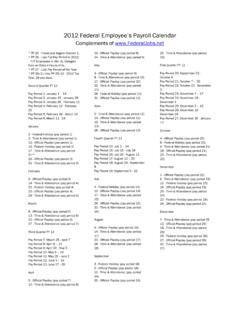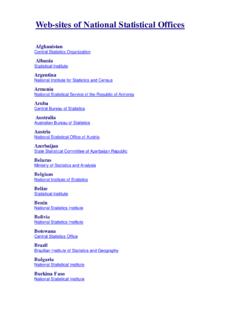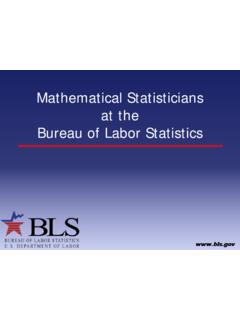Transcription of CHAPTER ONE Introduction to Government Employment
1 CHAPTER ONE. Introduction to Government Employment F ederal Employment increased dramatically over the past two years com- pared to the private sector, where unemployment hovers in the high single digits. From October 2009 through June 2010, agencies hired 212,188 new hires. Total em- ployment, including the Postal Service, was 2,850,280 as of September T he average annual salary Many retirements are projected as each day 10,000 baby boomers turn age now exceeds 65 for the next 19 years! Hiring will be driven by retirements and the need to staff $81,186. over 100 new agencies and regulatory organizations due to the healthcare and banking legislation passed in 2010.
2 There are many reasons to consider federal Employment . The average annual federal worker's compensation, pay plus benefits, is $123,049 compared to just $61,051 for the private Average salary is $81,258 and new hires can receive student loan payoff assistance, relocation and cash incentives for hard-to-fill posi- tions, and the benefits package is exceptional. A larger percentage of professionals and fewer service and clerical positions contribute to higher average salaries. Objectives are listed for key elements included in each CHAPTER . The image to the right is used throughout this book to highlight points of interest. CHAPTER OBJECTIVES.
3 O Understanding the opportunities O Determining the nature of federal Employment , working conditions, occupations, training, outlook, pay and benefits O What benefits to expect including retirement O How to develop your career and get promoted 1. Central Personnel Data File 9/2010 and the 2010 Comprehensive Statement of Postal Operations 2. Bureau of Economic Analysis, National Income & Product Account Tables and , 2010. 1. 2 The Book of Government Jobs It is difficult to imagine just how large the federal job market is until you compare it to its closest private-sector rival. Wal-Mart is the largest company world- wide, with annual sales of $530 billion and million workers.
4 Uncle Sam employs 750,000 more workers than Wal-Mart. Over the past two years alone over 200,000. new workers were hired to fill critical vacancies nationwide. The average annual salary for all pay plans increased from $67,186 in 2005 to $81,258 in 2010. The Government is the largest employer in the United States, hiring approximately 2 percent of the nation's civilian workforce. Job hunters will find helpful information and resources in this book to re- search Employment options, locate job vacancies, understand the federal job market, and apply for federal jobs. Numerous programs, options, and resources are reviewed and explained in detail, including: T How to approach the federal sector and identify available recruitment incentives including the student loan repayment and relocation pay- ments that are offered for hard-to-fill vacancies.
5 T The latest federal hiring reform and federal-style r sum guidance from Barbara Adams, President and CEO of CareerPro Global, Inc. CPG. combines several decades of industry-writing experience from entry-level to Senior Executive Service (SES), within or aspiring to work within the federal Government . T How to evaluate job announcements, answer occupational question- naires, obtain a Best Qualified rating, and write Knowledge, Skills, and Abilities (KSAs) statements that are still used in various forms for some positions. T Most non-Postal Service federal jobs, over 80 percent, don't require written exams. Determine whether your occupation requires a written entrance exam and if one is required how to prepare for it.
6 T Over a thousand resources are listed, including interactive employ- ment Web sites, an agency directory, occupation lists, skills index, and contact numbers for personnel specialists. T You will learn about student Employment programs, veterans prefer- ence, hiring opportunities for the disabled, law enforcement and over- seas job opportunities, Post Office jobs, and much more. T Prepare for interviews, learn about the generous pay and benefits, networking techniques, and how to locate and apply for jobs stateside and overseas. Introduction to Government Employment 3. You need to know how to take advantage of the federal hiring system and recent changes to successfully land the job you want in Government .
7 Excellent job opportunities are available for those who know how to tap this lucrative job market. All Government hiring is based on performance and quali- fications regardless of your gender, race, color, creed, religion, disability, or national origin. Where else can you apply for a high-paying entry-level job that offers em- ployment at thousands of locations internationally, excellent career advancement opportunities, and careers in hundreds of occupations? Government hired over a million part time workers in 2010 for the US. Census alone and continues to hire hundreds of thousands of full time workers each year. Other vacancies exist in the legislative and judicial branches.
8 Numerous job opportunities are available for those willing to seek them out. Many opportunities will be created as over 637,000 federal employees will become eligible for retirement in 2011 according to OPM's Analysis of Federal Employee Retirement Data Report, Table 2. The following statistical analysis will help you focus on just where the greatest opportunities are. The largest agencies are featured and their Employment trends analyzed. Large agencies hire a broad spectrum of workers in hundreds of occupations. It's best to expand your search to as many agencies as possible to improve your chances. Six agencies, including the Postal Service, employ approximately 75 percent of the workforce, or 2,137,710 employees.
9 Of the 89,204 overseas jobs 62,838 were citizens. The remaining overseas employees are foreign nationals. The changes from September of 2006 to September 2010 in Table 1-1 show that all agencies except the Postal Service increased Employment , some substantially. The Depart- ment of Defense increased by 76,555 employees. Overall, the total Employment increased by 7 percent while the Judicial branch essentially stayed the same and the Legislative branch Employment increased by 4 percent. The second largest increase was in Veterans Affairs; their Employment increased 27 percent, an increase of 65,569 workers. 4 The Book of Government Jobs TABLE 1-1.
10 The Six Largest Federal Departments Total Workforce 2,850, 280 100 %. Legislative branch 30,859 %. Judicial branch 33,754 %. USPS & PRC * 671,687 %. Executive (non-postal) 2,113,980 %. Defense 764,299. Veterans Affairs 308,814. Homeland Security 188,983. Justice 109,900. Treasury 116,901. Reference: Federal Civilian W orkforce Statistics S September 2010. * The United States Postal Service (USPS) and the Postal Rate Commission (PRC). NATURE OF FEDERAL Employment . The federal Government 's essential duties include defending the United States from foreign aggression and terrorism, representing interests abroad, enforcing laws and regulations, and administering domestic programs and citizens are particularly aware of the federal Government when they pay their income taxes each year, but they usually do not consider the Government 's role when they watch a weather forecast, purchase fresh and uncontaminated groceries, travel by highway or air, or make a deposit at their bank.






